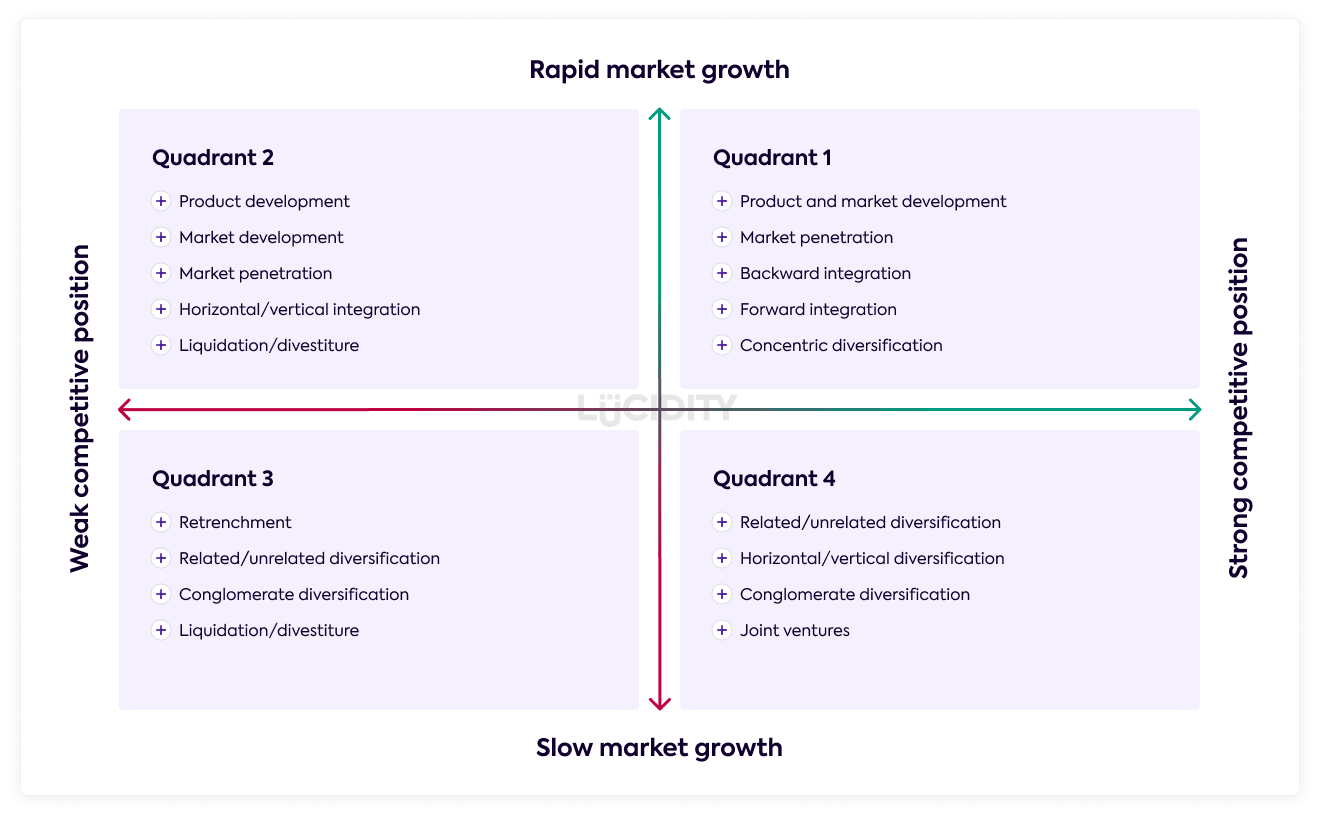The Grand Strategy Matrix is a newer strategic tool comparatively (decades younger than SWOT, ADL and co). It’s used to look through alternative strategies for companies and is gaining popularity since the launch in 2017.
What is the Grand Strategy Matrix?
The Grand Strategy Matrix charts two dimensions – the market growth vs the organisations competitive position. Each of the four quadrants has a number of strategic options and the framework is designed to assist you evaluate the potential direction you decide to move in as a business.
First Quadrant:
If your business is in this quadrant then you have a strong competitive position and the market is in rapid growth. Arguably this is the best quadrant to be in, with opportunity high and your position strong.
Second Quadrant:
If your business is in this quadrant then you have a relatively weak competitive situation as a business, but there’s a lot of opportunity to go for and a lot of success to be had within the market. The strategies in this position are all about why you’re not taking advantage of the position. If you’re placed in this quadrant then you know you can change to improve results.
Third Quadrant:
Being in the third quadrant means you have a weak competitive situation and the market is also quite slow. This is a tricky position because you’re already not doing well and there isn’t the huge opportunity that presents itself like the second quadrant. If you find yourself here you need to consider major changes to improve your competitive position, consider areas such as cost reduction, differentiation or diversification.
Fourth Quadrant:
If you’re placed within the fourth quadrant you have a strong competitive situation, which is great, but your market is slow to grow or in decline. This lends itself to strategies such as diversification as you have the funds to innovate in numerous areas before the market decline becomes unsustainable. Watch out for cheaper competitors entering the market to attack you as the leader.
What are the strategies in the Grand Strategy Matrix?
Strong Market Position + Strong Market Growth Strategies:
- Market Development
- Product Development
- Market Penetration
- Backward Integration
- Forward Integration
- Concentric Diversification
Weak Market Position + Strong Market Growth Strategies:
- Market Development
- Product Development
- Market Penetration
- Horizontal/Vertical Integration
- Liquidation
- Divestiture
Weak Market Positioning + Weak Market Growth Strategies:
- Related / Unrelated Diversification
- Conglomerate Diversification
- Retrenchment
- Liquidation
Strong Market Positing + Weak Market Growth Strategies:
- Related / Unrelated Diversification
- Horizontal / Vertical Diversification
- Joint Ventures
- Conglomerate Diversification
What are the advantages of the Grand Strategy Matrix?
The Grand Strategy Matrix has a number of advantages:
- It’s simple to use and understand
- It has a comprehensive list of strategic options
- It can stimulate discussion and help frame decisions
- It can be applied to any industry or marketplace
What are the limitations of the Grand Strategy Matrix?
There are some limitations such as:
- It only provides options rather than success criteria around them
- You need to use it with other tools
- The matrix is simplistic so loses some nuance
- Your business may operate in multiple quadrants if you have many products or services
What are the alternative tools to a Grand Strategy Matrix?
The Grand Strategy Matrix is a tool to chart the position of a product or company within a market, much like the ADL Matrix, and select certain strategies, similar to the Strategy Clock or Generic Strategies.
What preparation should be done before using a Grand Strategy Matrix?
You’ll need to understand your current performance within a market and the trajectory of that market in order to correctly position yourselves on the Grand Strategy Matrix.
How often should a company use the Grand Strategy Matrix?
Whenever a company is assessing their strategic options, the Grand Strategy Matrix can be used to generate discussion and options.














